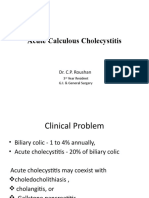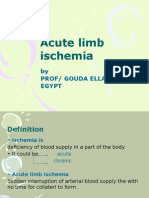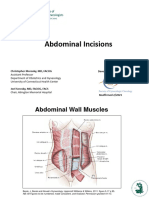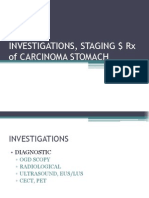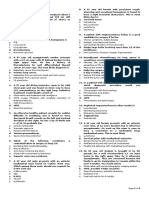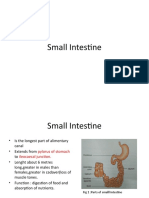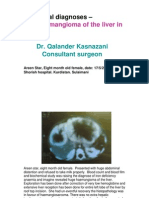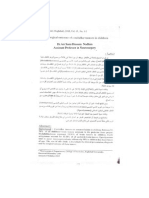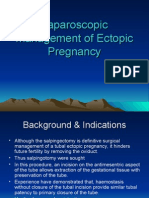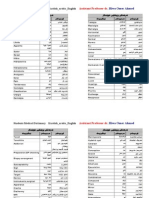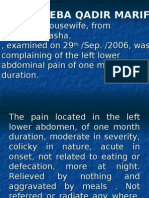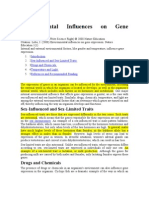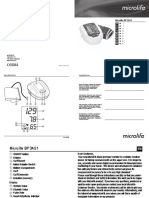100%(7)100% found this document useful (7 votes)
1K viewsMirizzi Syndrome
Mirizzi Syndrome
Uploaded by
drhiwaomerMirizzi syndrome is a rare condition caused by gallstones becoming lodged in the cystic duct or gallbladder, externally compressing the common hepatic duct and causing jaundice. It was first described by Dr. P.L. Mirizzi in 1948. Chronic inflammation from gallstones can cause scarring and fistula formation between the gallbladder and common hepatic duct. Mirizzi syndrome is typically treated with cholecystectomy and reconstruction of the common bile duct.
Copyright:
Attribution Non-Commercial (BY-NC)
Available Formats
Download as PPT or read online from Scribd
Mirizzi Syndrome
Mirizzi Syndrome
Uploaded by
drhiwaomer100%(7)100% found this document useful (7 votes)
1K views18 pagesMirizzi syndrome is a rare condition caused by gallstones becoming lodged in the cystic duct or gallbladder, externally compressing the common hepatic duct and causing jaundice. It was first described by Dr. P.L. Mirizzi in 1948. Chronic inflammation from gallstones can cause scarring and fistula formation between the gallbladder and common hepatic duct. Mirizzi syndrome is typically treated with cholecystectomy and reconstruction of the common bile duct.
Original Description:
case presentation
Copyright
© Attribution Non-Commercial (BY-NC)
Available Formats
PPT or read online from Scribd
Share this document
Did you find this document useful?
Is this content inappropriate?
Mirizzi syndrome is a rare condition caused by gallstones becoming lodged in the cystic duct or gallbladder, externally compressing the common hepatic duct and causing jaundice. It was first described by Dr. P.L. Mirizzi in 1948. Chronic inflammation from gallstones can cause scarring and fistula formation between the gallbladder and common hepatic duct. Mirizzi syndrome is typically treated with cholecystectomy and reconstruction of the common bile duct.
Copyright:
Attribution Non-Commercial (BY-NC)
Available Formats
Download as PPT or read online from Scribd
Download as ppt
100%(7)100% found this document useful (7 votes)
1K views18 pagesMirizzi Syndrome
Mirizzi Syndrome
Uploaded by
drhiwaomerMirizzi syndrome is a rare condition caused by gallstones becoming lodged in the cystic duct or gallbladder, externally compressing the common hepatic duct and causing jaundice. It was first described by Dr. P.L. Mirizzi in 1948. Chronic inflammation from gallstones can cause scarring and fistula formation between the gallbladder and common hepatic duct. Mirizzi syndrome is typically treated with cholecystectomy and reconstruction of the common bile duct.
Copyright:
Attribution Non-Commercial (BY-NC)
Available Formats
Download as PPT or read online from Scribd
Download as ppt
You are on page 1of 18
MIRIZZI SYNDROME
Dr. Hiwa Omer Ahmed
ASSISTANT PROFESSOR IN
SURGERY
MIRIZZI SYNDROME
• The stone ulcerating through into the CBD
• Mirizzi's syndrome is a condition
characterized by stricture of the common
hepatic duct.
• Mirizzi's syndrome may be mistaken for
pancreatic cancer or cholangiocarcinoma
P. L. Mirizzi
• In 1948, P. L. Mirizzi described an unusual
presentation of gallstones which, when
lodged in either the cystic duct or the
Hartmann pouch of the gallbladder,
externally compressed the common
hepatic duct (CHD), causing symptoms of
obstructive jaundice (Mirizzi, 1948).
Pathophysiology:
• Impaction of a large gallstone (or multiple small
gallstones) in the Hartmann pouch or cystic duct results
in the Mirizzi syndrome in 2 ways: (1) Chronic and/or
acute inflammatory changes lead to contraction of the
gallbladder, which then fuses with and causes secondary
stenosis of the CHD, or (2) large impacted stones lead to
cholecystocholedochal fistula formation secondary to
direct pressure necrosis of the adjacent duct walls.
Increasingly, these phenomena are seen not as distinct
and separate steps but as part of a continuum
(Pemberton, 1997; Hazzan, 1999
• In 1982, McSherry et al proposed a 2-
stage classification based on the results of
endoscopic retrograde
cholangiopancreatography (ERCP) and
percutaneous transhepatic
cholangiography (PTC). Type I is simple
external compression of the CHD,
whereas type II involves the presence of a
cholecystocholedochal fistula
Frequency:
• In the US: Mirizzi syndrome occurs in
approximately 0.7-1.4% of all patients
undergoing cholecystectomy and in 0.1%
of all patients with gallstone disease
(Pemberton, 1997; Hazzan, 1999).
Mortality/Morbidity
• : Preinterventional diagnosis of this rare condition is critical to the
patient's prognosis. Chronic inflammation that leads to fibrosis,
scarring, edema, and fistula formation can wreak havoc on adjacent
biliary structures and cause serious surgical consequences if
unnoticed. Therefore, every patient in whom this abnormality is
suspected (at initial ultrasonography or CT) must undergo anatomic
evaluation with cholangiography prior to surgical intervention.
• Extensive adhesions may make visualization of the biliary anatomy
exceptionally difficult, especially within the hepatoduodenal
ligament. Consequently, the CBD may be mistaken for the cystic
duct, and ligation or permanent injury may occur during surgery
(Becker, 1984). Postoperative bile leakage may occur if a fistula is
not recognized; rarely, this may result in bile peritonitis
: the cystic duct is densely adherent to the
CBD causing necrosis and fistulla
between cystic duct,GB and CBD
What Causes Mirizzi's
syndrome?
• Mirizzi's syndrome is caused by chronic
cholecystitis and large gallstones resulting in
constriction of the common bile duct.
cholecystitis is an inflammation of the
gallbladder that causes severe abdominal pain.
• In some cases, the gallstone erodes into the
common hepatic duct and produces a
cholecystocholedochal fistula.
Symptoms of Mirizzi's
syndrome?
• cholecystitis
• fever
• right upper quadrant pain recurrent
• cholangitis
• jaundice
• elevated bilirubin
• pancreatitis
cholangiogram
Findings
• : Ultrasonographic findings include (1) an
impacted calculus in the Hartmann pouch
or the cystic duct, (2) dilatation of the CHD
above the level of the impacted stone, (3)
narrowing of the CHD at the level of
impaction, and (4) normal caliber of the
CBD below the impaction
Can Mirizzi's Syndrome be
Treated?
• Yes. Common treatments include removal
of the gallbladder and reconstruction of
the common bile duct and the hepatic
duct.
Rx
• Mirizzi syndrome types II-IV (ie, fistula
present) require more complex
interventions. Type II defects are generally
treated successfully with either
cholecystectomy and closure around a t-
tube or partial cholecystectomy with in situ
t-tube placement (Pemberton, 1997).
Our patient
You might also like
- English-Kurdish - Arabic Medical DictionaryDocument110 pagesEnglish-Kurdish - Arabic Medical Dictionarydrhiwaomer80% (15)
- Anatomy of OesophagusDocument25 pagesAnatomy of OesophagusRabi SyedNo ratings yet
- Urinary RetentionDocument64 pagesUrinary RetentionAntonioIndraTNo ratings yet
- The Types of Hemorrhoidectomy Procedures IncludeDocument9 pagesThe Types of Hemorrhoidectomy Procedures IncludeKim SunooNo ratings yet
- Butler Technique StudyDocument67 pagesButler Technique StudySachin080867% (3)
- Case Studies - Prudence Comes With FortitudeDocument5 pagesCase Studies - Prudence Comes With FortitudeKarl Jason Dolar Comin100% (1)
- Biocon Business EthicsDocument21 pagesBiocon Business EthicsNirjon Dip100% (1)
- Acute Calculous CholecystitisDocument25 pagesAcute Calculous CholecystitisShankar Lamichhane100% (1)
- Fascial Spaces in The HandDocument20 pagesFascial Spaces in The Handveegeer80% (5)
- Acute Limb IschemiaDocument16 pagesAcute Limb IschemiaMohammad Husni BanisalmanNo ratings yet
- Disease of The Biliary Tract: Abdifatah Osman Nur, MBBS, Mmed (General Surgery)Document33 pagesDisease of The Biliary Tract: Abdifatah Osman Nur, MBBS, Mmed (General Surgery)DrAisha QalbinurNo ratings yet
- Abdominal IncisionsDocument51 pagesAbdominal IncisionsFransisko ReinardNo ratings yet
- 54.the Gallbladder and Bile DuctsDocument19 pages54.the Gallbladder and Bile DuctsAdenegan Adesola RaymondNo ratings yet
- PeritonitisDocument34 pagesPeritonitisabrar_zaidiNo ratings yet
- Block Hepatobiliary SystemDocument29 pagesBlock Hepatobiliary SystemKevin KusumanNo ratings yet
- ESMO Epidemiology Classification and Clinical Presentation of NETs A European PerspectiveDocument39 pagesESMO Epidemiology Classification and Clinical Presentation of NETs A European PerspectiveMario MutuleanuNo ratings yet
- Peri Ampullary TumorDocument69 pagesPeri Ampullary TumorMuhammed Muzzammil SanganiNo ratings yet
- EXAM QUESTIONS On Wound Healing and Surgical Site InfectionsDocument2 pagesEXAM QUESTIONS On Wound Healing and Surgical Site Infectionsjc_sibal13No ratings yet
- Approach To Jaundice PatientDocument24 pagesApproach To Jaundice Patientabela_amuluNo ratings yet
- 6 Imaging of Acute AbdomenDocument73 pages6 Imaging of Acute AbdomenAliyah Tofani PawelloiNo ratings yet
- Acute Intestinal IschemiaDocument50 pagesAcute Intestinal IschemiaRohit ParyaniNo ratings yet
- Carcinoma StomachDocument43 pagesCarcinoma StomachRukman Mecca100% (1)
- R HemicolectomyDocument15 pagesR Hemicolectomyrwilah100% (1)
- Posterior Abdominal WallDocument59 pagesPosterior Abdominal WallAmeen ShaikNo ratings yet
- 2 - Vascular InjuryDocument6 pages2 - Vascular Injuryمحمد عماد عليNo ratings yet
- Esophageal Cancers: Najam Uddin FCPS-II (Radiotherapy) Resident AEMC KarachiDocument104 pagesEsophageal Cancers: Najam Uddin FCPS-II (Radiotherapy) Resident AEMC KarachimahnoorNo ratings yet
- Techniques of Bowel Resection and AnastomosisDocument7 pagesTechniques of Bowel Resection and Anastomosisfaris nagib100% (1)
- Rectal ProlapseDocument29 pagesRectal ProlapseErick AkwanNo ratings yet
- Differential Diagnosis Pain Right HypochondriumDocument35 pagesDifferential Diagnosis Pain Right HypochondriumDrArish Mahmood100% (1)
- Urethral Injuries: Ahmed S. ZugailDocument56 pagesUrethral Injuries: Ahmed S. Zugailmanoj bhartiNo ratings yet
- Thyroid GlandDocument21 pagesThyroid GlandMAH pedNo ratings yet
- Surgery 6th TCVSDocument3 pagesSurgery 6th TCVSRem AlfelorNo ratings yet
- Inguinal Scrotal SwellingsDocument23 pagesInguinal Scrotal SwellingsAzmyza Azmy100% (1)
- 2.4.5.2.3.a Bowel ObstructionDocument35 pages2.4.5.2.3.a Bowel ObstructionProject ByNo ratings yet
- AppendicitisDocument49 pagesAppendicitissidehustlemrayNo ratings yet
- HerniaDocument79 pagesHernianorhafizahstoh89No ratings yet
- PeritonitisDocument42 pagesPeritonitisvriliadiar100% (1)
- Radiological Anatomy of Biliary SystemDocument29 pagesRadiological Anatomy of Biliary SystemNishant RajNo ratings yet
- Esophageal CancerDocument34 pagesEsophageal CancerEzequiel GarciaNo ratings yet
- Small IntestineDocument24 pagesSmall IntestineMunawwar Mohd AdnanNo ratings yet
- Dr. Kunta Setiaji (ThyroidNodule)Document17 pagesDr. Kunta Setiaji (ThyroidNodule)Hasty WahyuniNo ratings yet
- Alterations in The Surgical Patient Updated 2010Document122 pagesAlterations in The Surgical Patient Updated 2010zorrotranNo ratings yet
- Surgery Notes PDFDocument7 pagesSurgery Notes PDFhassan_5953No ratings yet
- Biliary Surgery: Presenter: DR Muhuga JR Facilitator: DR MwashambwaDocument54 pagesBiliary Surgery: Presenter: DR Muhuga JR Facilitator: DR MwashambwaSamar AhmadNo ratings yet
- Development of MesentryDocument28 pagesDevelopment of MesentryimmmiNo ratings yet
- Laparoscopic Abdominoperineal ResectionDocument19 pagesLaparoscopic Abdominoperineal ResectionJohnson Mallibago100% (2)
- Extrahepatic CholestasisDocument9 pagesExtrahepatic CholestasisMatet MonjeNo ratings yet
- Intestinal Atresia and StenosisDocument7 pagesIntestinal Atresia and StenosisMichael NafarinNo ratings yet
- Treatment: Bassini RepairDocument5 pagesTreatment: Bassini RepairziehonkNo ratings yet
- CHOLEDOCHOLITHIASISDocument8 pagesCHOLEDOCHOLITHIASISkuncupcupu1368No ratings yet
- PhlegmonDocument15 pagesPhlegmonAam PurnamaNo ratings yet
- Inguinoscrotal Swelling in PediatricsDocument84 pagesInguinoscrotal Swelling in Pediatricshayssam rashwan90% (10)
- (DERMA) 03 TineasDocument9 pages(DERMA) 03 TineasJolaine ValloNo ratings yet
- Malrotation of Gut: Pravin NarkhedeDocument44 pagesMalrotation of Gut: Pravin Narkhedepravin narkhede0% (1)
- Gastric Cancer PowerPoint PresentationDocument36 pagesGastric Cancer PowerPoint PresentationHaneef SafvanNo ratings yet
- Surgey MCQSDocument95 pagesSurgey MCQSZain HadiNo ratings yet
- Surgery ExamDocument82 pagesSurgery Examrajarajachozhan139No ratings yet
- Acute AbdomenDocument19 pagesAcute Abdomenmazin89No ratings yet
- Anorectal Malformatio N: Dr. O. Sankoh M.D. House Officer Pediatric SurgeryDocument123 pagesAnorectal Malformatio N: Dr. O. Sankoh M.D. House Officer Pediatric SurgeryMohamed KamaraNo ratings yet
- Acute PancreatitisDocument46 pagesAcute PancreatitisLew NianNo ratings yet
- Preoperative Preparation and Postoperative CareDocument103 pagesPreoperative Preparation and Postoperative Carechowhan04No ratings yet
- Case Study Presented by Group 22 BSN 206: In-Depth View On CholecystectomyDocument46 pagesCase Study Presented by Group 22 BSN 206: In-Depth View On CholecystectomyAjiMary M. DomingoNo ratings yet
- Mirizzi Syndrome-Rare Cause of Major Biliary Complications. Case ReportDocument3 pagesMirizzi Syndrome-Rare Cause of Major Biliary Complications. Case ReportWelviraHandayaniNo ratings yet
- Laparoscopy AtlasDocument199 pagesLaparoscopy Atlasdrhiwaomer100% (2)
- Day Case Surgery 1LDocument21 pagesDay Case Surgery 1LdrhiwaomerNo ratings yet
- Thyroid& ParathyroidDocument98 pagesThyroid& Parathyroiddrhiwaomer100% (12)
- GlaiyDocument1 pageGlaiydrhiwaomerNo ratings yet
- Liver Haemangioma ResectionDocument38 pagesLiver Haemangioma ResectiondrhiwaomerNo ratings yet
- Indications in SrgeryDocument73 pagesIndications in Srgerydrhiwaomer100% (4)
- Inhalational AgentsDocument12 pagesInhalational Agentsdrhiwaomer100% (1)
- Laparoscopic Tubal SterilizationDocument8 pagesLaparoscopic Tubal SterilizationdrhiwaomerNo ratings yet
- Laparoscopic Tubal SterilizationDocument8 pagesLaparoscopic Tubal SterilizationdrhiwaomerNo ratings yet
- ژوان Kurdish Short storyDocument2 pagesژوان Kurdish Short storydrhiwaomerNo ratings yet
- Hepatoblastoma ResectionDocument21 pagesHepatoblastoma ResectiondrhiwaomerNo ratings yet
- CV DR Ari Sami 2008Document4 pagesCV DR Ari Sami 2008drhiwaomer100% (2)
- Surgical Outcome of Cerebellar Tumors in ChildrenDocument10 pagesSurgical Outcome of Cerebellar Tumors in ChildrendrhiwaomerNo ratings yet
- PremedicationDocument9 pagesPremedicationdrhiwaomer100% (3)
- Indications and Contraindications of Laparoscopy1Document18 pagesIndications and Contraindications of Laparoscopy1drhiwaomer100% (2)
- Laparoscopic Management of Ectopic PregnancyDocument7 pagesLaparoscopic Management of Ectopic Pregnancydrhiwaomer100% (3)
- Kurdish / Arabic/englsh Medical DictionaryDocument82 pagesKurdish / Arabic/englsh Medical Dictionarydrhiwaomer89% (9)
- Diagnostic LaparosDocument8 pagesDiagnostic Laparosdrhiwaomer100% (3)
- Anesthesia Lecture 3Document25 pagesAnesthesia Lecture 3drhiwaomer100% (2)
- Intravenous Anesthetic AgentsDocument23 pagesIntravenous Anesthetic Agentsdrhiwaomer100% (7)
- Post Operative ComplicationsDocument17 pagesPost Operative Complicationsdrhiwaomer100% (8)
- Anesthesia Lecture 3Document25 pagesAnesthesia Lecture 3drhiwaomer100% (2)
- Anesthesia Lecture 1Document16 pagesAnesthesia Lecture 1drhiwaomer100% (9)
- Metastatized Colonic CancerDocument17 pagesMetastatized Colonic Cancerdrhiwaomer100% (3)
- High Output Renal FailureDocument4 pagesHigh Output Renal Failuredrhiwaomer100% (1)
- Hand Fractures PDFDocument92 pagesHand Fractures PDFfiestaNo ratings yet
- Tads 1Document6 pagesTads 1travolta0No ratings yet
- Pre and Postoperative CareDocument17 pagesPre and Postoperative CaremeghanaNo ratings yet
- Propranolol-Induced Circulatory Collapse in A Patient With Thyroid Crisis and Underlying Thyrocardiac Disease: A Word of CautionDocument10 pagesPropranolol-Induced Circulatory Collapse in A Patient With Thyroid Crisis and Underlying Thyrocardiac Disease: A Word of CautionsuadaslanNo ratings yet
- Fiche Technique WED 9618Document2 pagesFiche Technique WED 9618Ralf WolwerineNo ratings yet
- Answers and Rationale Medical Surgical Nursing Practice Test Part 3Document4 pagesAnswers and Rationale Medical Surgical Nursing Practice Test Part 3Anna Marie AmpoNo ratings yet
- CytokineDocument26 pagesCytokinePro KartuNo ratings yet
- Mode of TransmissionDocument50 pagesMode of TransmissionHairul AnuarNo ratings yet
- Study of Healthcare Facilities and Access To Healthcare in Badshahibagh and Near VillagesDocument17 pagesStudy of Healthcare Facilities and Access To Healthcare in Badshahibagh and Near VillagesMd Kashif RazaNo ratings yet
- Noel A. Villanueva, MD, FPCP, FPSNDocument62 pagesNoel A. Villanueva, MD, FPCP, FPSNagilNo ratings yet
- Environmental Influences On Gene ExpressionDocument4 pagesEnvironmental Influences On Gene Expressionkinbisabell0% (1)
- Fundamentals of NursingDocument10 pagesFundamentals of NursingDale GallegosNo ratings yet
- E NabhDocument64 pagesE NabhRenuka Murugan100% (1)
- Rajasthan Pre Medical Test-2011: Information Booklet (RPMT-2011)Document19 pagesRajasthan Pre Medical Test-2011: Information Booklet (RPMT-2011)Arun PurohitNo ratings yet
- Lawrence Owino Okongo Paediatric Rheumatologist: List of Privileges Allergy/Immunology DisordersDocument5 pagesLawrence Owino Okongo Paediatric Rheumatologist: List of Privileges Allergy/Immunology DisordersMARTINNo ratings yet
- Pi Is 0363502313014159Document9 pagesPi Is 0363502313014159Muchamad Wisuda RiswantoNo ratings yet
- Cheaklist ManifestoDocument56 pagesCheaklist Manifestositos13919No ratings yet
- Stephen Holt MD-Integrative Medicine Definitions and InitiativesDocument23 pagesStephen Holt MD-Integrative Medicine Definitions and InitiativesStephen Holt MD100% (3)
- 2002 Smith Etal Medicinal Mushrooms Complete PDFDocument266 pages2002 Smith Etal Medicinal Mushrooms Complete PDFmajik100% (1)
- ISO 10993 17 MDCPSS Webinar Part 1Document47 pagesISO 10993 17 MDCPSS Webinar Part 1Antonio MartinsNo ratings yet
- List Obat Lasa/ Norum Berdasarkan Ucapan MiripDocument3 pagesList Obat Lasa/ Norum Berdasarkan Ucapan MiripYusufa Ibnu Sina SetiawanNo ratings yet
- Mid TermDocument17 pagesMid TermTamoghna NaskarNo ratings yet
- Ethicsof SuicideDocument12 pagesEthicsof SuicidesergeyNo ratings yet
- 2 - Batiquin v. CA - G.R. No. 118231Document2 pages2 - Batiquin v. CA - G.R. No. 118231Setsuna05217No ratings yet
- Safety QuizDocument9 pagesSafety Quizsaravan1891No ratings yet
- Standard Treatment GuidelinesDocument5 pagesStandard Treatment Guidelinesbournvilleeater100% (1)
- Microlife BP 3AG1Document59 pagesMicrolife BP 3AG1Luis SotoNo ratings yet







